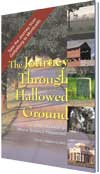My wife and I took our annual tour last weekend through the beautiful Virginia countryside to partake of fall foliage, lovely vistas, wine tasting, fine dining and the Commonwealth’s rich historical heritage. It just so happens that the area we love the most — the rolling hills between Charlottesville and the Potomac River — overlaps with the Virginia portion of the Journey Through Hallowed Ground.
Among the friends we visited was Cate Magennis Wyatt, who, as coincidence would have it, is the driving force behind Journey Through Hallowed Ground. Her immediate goal is to win federal designation as a National Heritage Area for the historical swath between Charlottesville and Gettysburg, Pa. Longer term, she wants to preserve historical sites as well as the unique landscapes and lifestyles of the region by building tourism and agriculture.
Wyatt, a former real estate portfolio manager and developer, is a capitalist. She is building a preservation program based on respect for property rights and market principles. The National Heritage Area designation, she says, will prohibit the acquisition of land through condemnation. Further, no federal funds from the NHA legislation will be used to purchase land. The proper way to preserve the region’s history and character, Wyatt insists, is (a) to build awareness of the region’s rich heritage, (b) to raise private funds to buy irreplaceable properties, and (c) to find economic models for agriculture and tourism that will make the property more valuable in its current uses than it would be if carved up for subdivisions and shopping centers.
Wyatt outlines some of her views in an op-ed piece in the Loudoun Times-Mirror. But that column barely scratches the surface of her fertile thinking. Some of her ideas are still in the formulation stage, so it is premature to discuss them. Suffice it to say that if a mere fraction of them come to fruition, Journey Through Hallowed Ground will become a textbook study in historical conservation.
By the way, if you’re looking for a fun weekend retreat, consider Virginia’s northern piedmont. You can order the Journey Through Hallowed Ground travel guide here.


Leave a Reply
You must be logged in to post a comment.